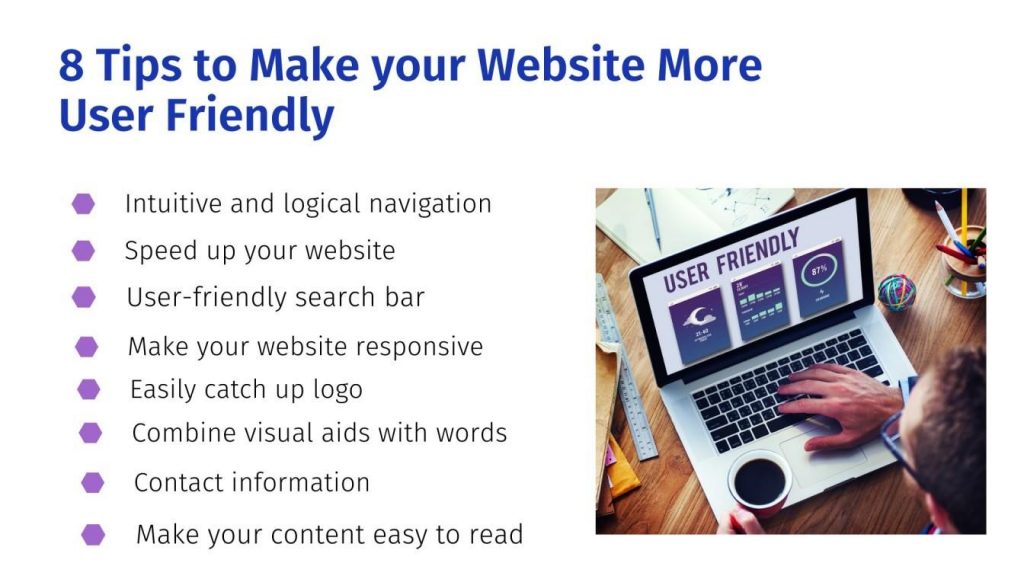Websites have evolved into much more than a collection of text and information on a single page. Users want your website to engage them, deliver high-quality information, and give a straightforward, enjoyable user experience. With so many amazing web development and design trends developing daily, arriving on a mediocre website is a real letdown.
To get the perfect website according to your requirements, you can approach any web design company. It’s as if your website doesn’t exist if it’s difficult for people to locate what they’re searching for, has broken links, or takes too long to load.
With more consumers opting to conduct business entirely online, having a user-friendly website is no more optional if you want to be successful. Here are a few easy suggestions for developing a user-friendly website to ensure that potential clients have a productive and happy experience
8 Tips to Make your Website More User Friendly

1. Intuitive and logical navigation
The navigation on your website must be simple. This implies it follows established norms to appear and act the way consumers expect it to. Don’t try to figure out how to navigate on your own. Even if you explain how to use it, most consumers will be uninterested in learning.
A decent navigation menu should be simple to use and have clear links. A drop-down menu or, better yet, a mega menu should be used if there are too many links. Users will be able to quickly traverse the site and locate what they’re looking for in this method.
2. Speed up your website
Even on mobile devices, web consumers want your site to load quickly. About half of them say they expect a website to load in two seconds or less, and that if it takes more than three seconds, they would quit it. When it comes to keeping people on your site so they can decide if they want to do business with you, speed does matter.
Pingdom and Google’s Page Speed Insights are two tools that may help you test your site speed. These sites will also provide you with suggestions on how to improve the performance of your website. Checking your server’s performance and optimising any graphics are two basic things you can do to get started.
3. User-friendly search bar
Websites featuring a search bar offer an added benefit in terms of usability. This is especially true if your search feature includes features like related content suggestions, allowing users to type in typos and alternate spellings, highlighting search words in results, providing exact search by various parameters (faceted search), displaying the most relevant search results first, and more.
4. Make your website responsive to mobile devices
People utilise mobile devices to search the internet for information. As a result, you must determine how your company’s website appears and how visitors access it on mobile devices. A user-friendly website nowadays is one that is also mobile-friendly. The design must be mobile-friendly.
Keep in mind that your navigational system for mobile devices will differ from that of a desktop website. The buttons must be placed in such a way that they can be readily tapped with fingers on the little screen. Your responsive design layout should also be capable of producing optimal pictures.
5. Make it easy for people to find your logo
Make people look for your logo or brand identification, not the other way around. Give users what they want by placing your logo in the upper left corner of your page. This helps people to quickly recognise your brand. Your logo should also be clickable, directing people back to the main page from anywhere on your website.
6. For clarity, combine visual aids with words
Because different forms of calls-to-action elicit varied responses, site designers will frequently employ both an informative symbol and a textual hint to make them as plain as feasible. A clickable envelope icon with text that says “Click Here” or “Email Us” may, for example, be used to convey a link to your “Contact Us” page. Make sure these items are properly defined and put in visible areas.
7. Contact information
Your logo is the most important aspect of your website. Your logo and contact information, on the other hand, are two things that your website needs. You might be losing out on a lot of potential business if your contact information isn’t clearly available on your website.
The more information you provide, the easier it will be for others to reach you in the method that is most convenient for them. A phone number, email address, and company address are normally sufficient, but it isn’t a bad idea to mention your business hours so that people know when they can reach you.
8. Make your content easy to read
You must consider the readability of your website’s content in order to make it user-friendly. Remember that many individuals will not read your entire material from beginning to end, but will only skim over it, and they should be able to get your point fast.
Readable fonts, colour contrasts, highlights when needed, clear headings and subheadings, bulleted or numbered lists, paragraph division with no large slabs of text, a proper balance between texts and pictures, layouts with useful columns, and more will be your helpful helpers here.
Reach out to a digital marketing company if you want to make your website more user friendly.


